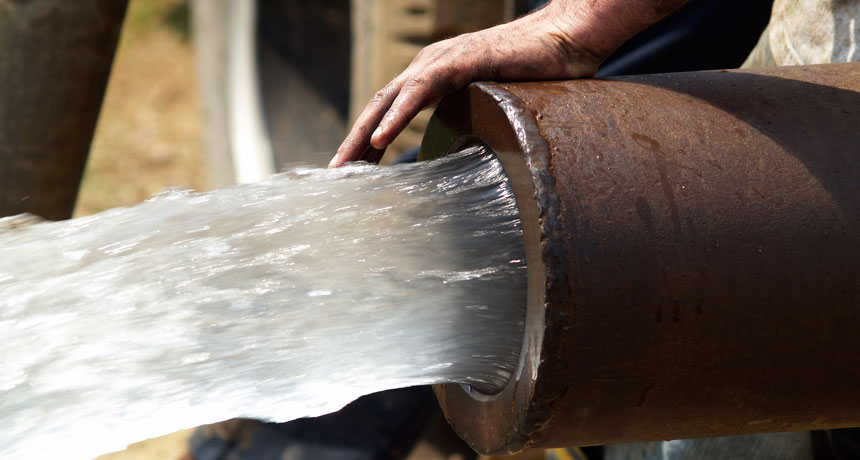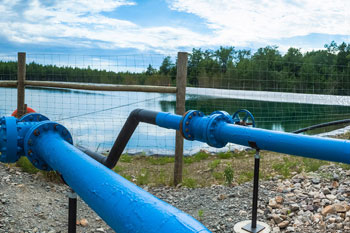Water: Getting the salt out
Researchers develop a simple way to remove salt and some other dissolved substances from polluted water

Researchers have developed a new way to remove salt and some other dissolved substances from water. This could help purify tainted groundwater or desalinate seawater.
Walter Galloway/istockphoto
By Sid Perkins
The world’s population is ever rising. And the more people there are, the more need there is for clean drinking water. Now, researchers have come up with a new way to remove many pollutants from water, including salt: They zap it.
The oceans hold about 97 percent of Earth’s water. Its salt content makes it undrinkable. Other water that is pumped from underground often has minerals dissolved in it. So this water, too, can be undrinkable (or at least not tasty). Scientists have developed many methods to remove impurities from water. But those methods often take lots of energy. And that makes them costly.
But Martin Bazant and his teammates have come up with a new method that could lower the cost. Bazant works at the Massachusetts Institute of Technology in Cambridge. And as a chemical engineer, he uses chemistry to solve problems related to the production of food, fuel and other products. Many of the methods now used to separate fresh water from salty use some sort of barrier, such as a filter. Those barriers often are designed to let water pass through, but block larger atoms, such as sodium and chlorine. (Those two elements are what make up table- and sea salts.)
Bazant’s group instead made a system that doesn’t use physical barriers. It takes advantage of the fact that sodium and chlorine particles have an electrical charge. Charged particles are called ions. And the new system uses electricity to steer the ions dissolved in water in a particular direction. This separates them from a stream of fresh (unsalty) water. Bazant’s team published its results November 3 in Environmental Science and Technology Letters.
Here’s how it works
The MIT team pushes the water they’re trying to purify through a porous material. That means it contains many tiny holes. (For its tests, the team built a system small enough to sit on a bench in a laboratory. They used a material made of tiny glass particles. Those tiny bits were fused together to make a solid object that looked somewhat like a sponge.) Then, they place that material between a positive and a negative electrode and send an electric current through it. That current separates the water flowing through the material into two different zones. One part of the stream contains sodium and chlorine ions. So this water becomes exceptionally salty. The other part of the stream contains fresh water. On the downstream side of the porous material, a simple divider channels the fresh water into a separate area.

The system only steers charged particles. So it won’t remove pollutants that have no electric charge. And the now extra-salty (or polluted) portion of the water will need to be treated as a waste.
Particularly due to its inexpensive materials, the new system “opens up a whole range of possibilities,” says Maarten Biesheuvel. He’s an environmental engineer at the European Center of Excellence for Sustainable Water Technology. That’s a research institute in Leeuwarden, The Netherlands. There, scientists and engineers study how to develop water-cleanup methods that are (among other things) easier on the environment.
Biesheuvel suspects the system could be used to pull salt out of seawater. It might also help remove salts from groundwater. He says it even might be used to remove the dissolved salts from the fluids left over from the hydraulic fracturing (fracking) of rocks to extract gas and oil.
Plus, Biesheuvel adds, the new study will likely lead to even more research. For example, scientists and engineers will want to figure out how to make the systems larger and more efficient. “I expect that this discovery will be a big ‘hit’ in the academic field,” he says.
Power Words
(for more about Power Words, click here)
academic Relating to school, classes or things taught by teachers in formal institutes of learning (such as a college).
bacterium (plural bacteria) A single-celled organism. These dwell nearly everywhere on Earth, from the bottom of the sea to inside animals.
chemical engineer A researcher who uses chemistry to solve problems related to the production of food, fuel, medicines and many other products.
chlorine A chemical element with the scientific symbol Cl. It is sometimes used to clean water. Compounds that contain chlorine are called chlorides.
desalination The removal of salt from some substance. This process is often used to generate fresh water.
dissolve To turn a solid into a liquid and disperse it into that starting liquid. For instance, sugar or salt crystals (solids) will dissolve into water. Now the crystals are gone and the solution is a fully dispersed mix of the liquid form of the sugar or salt in water.
electrode Material that serves as an anode or cathode, attracting negatively or positively charged particles. Or things that serve as electric conductors through which current leaves or enters something else.
element (in chemistry) Each of more than one hundred substances for which the smallest unit of each is a single atom. Examples include hydrogen, oxygen, carbon, lithium and uranium.
environmental engineer A person who uses science to study and improve the natural environment.
fresh water The very-low-salt water used for drinking.
fusion (v. to fuse) The merging of two things to form a new combined entity.
groundwater Water that is held underground in the soil or in pores and crevices in rock.
hydraulic fracturing, or fracking The cracking open of underground rocks by introducing liquid at high pressure, especially to extract natural gas. Those cracks are then held open by sand that had been added to the fracking fluid.
ion An atom or molecule with an electric charge due to the loss or gain of one or more electrons.
mineral The crystal-forming substances, such as quartz, apatite, or various carbonates, that make up rock. Most rocks contain several different minerals mish-mashed together. A mineral usually is solid and stable at room temperatures and has a specific formula, or recipe (with atoms occurring in certain proportions) and a specific crystalline structure (meaning that its atoms are organized in certain regular three-dimensional patterns).
molecule An electrically neutral group of atoms that represents the smallest possible amount of a chemical compound. Molecules can be made of single types of atoms or of different types. For example, the oxygen in the air is made of two oxygen atoms (O2), but water is made of two hydrogen atoms and one oxygen atom (H2O).
porous The description of a substance that contains tiny holes through which a liquid or gas can pass.
prototype A first or early model of some device, system or product that still needs to be perfected.
salt A compound made by combining an acid with a base (in a reaction that also creates water).
sodium A soft, silvery metallic element that will interact explosively when added to water. It is also a basic building block of table salt (a molecule of which consists of one atom of sodium and one atom of chlorine: NaCl).







